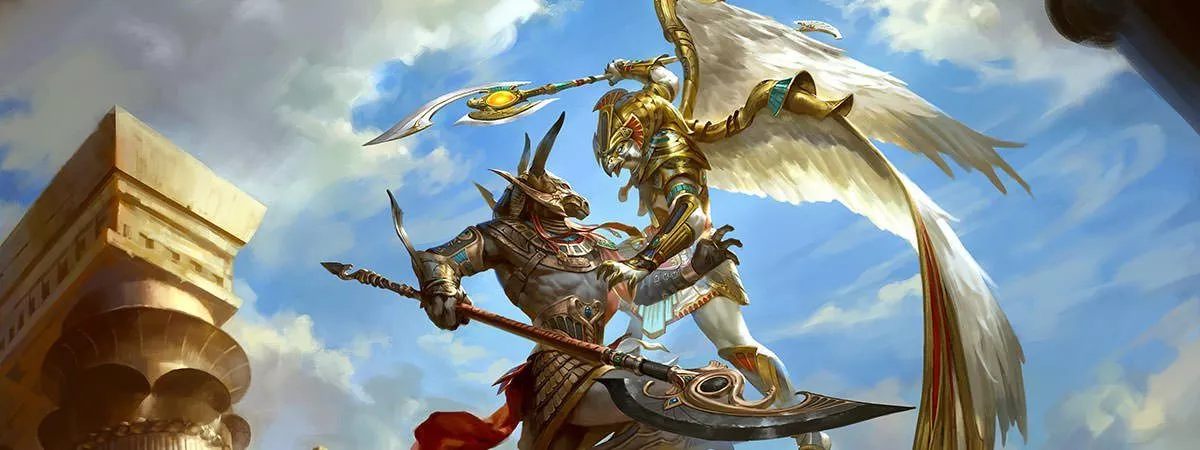Horus, also known as Her, Heru or Hor, was one of the most important deities of the ancient Egyptian civilization. Alternatively, he is also known as Neferhor and Harsiesis. Horus was worshiped as a god of the sky, war, hunting, order and justice; and he was depicted as a falcon-headed man. In Egyptian mythology, the right eye of Horus represented the Sun whereas his left eye represented the moon. Accordingly, he was also sometimes worshiped as the Sun God. There were various falcon deities which were merged with Horus. However, Horus primarily represents two deities Horus the Elder, one of the five original gods; and Horus the Younger, the son of Osiris and Isis who played a major role in the famous Osiris Myth.
As Horus represented order and justice, the Egyptian pharaohs associated themselves with him and even took on a Horus Name when they ascended the throne. For the general populace, Horus was their protector and was called for in times of need. Today, Horus remains a prominent figure in pop culture and he appears in numerous films, television series and games. Here are 10 interesting facts about the Ancient Egyptian God Horus.
#1 THE TERM HORUS HAS BEEN USED FOR VARIOUS FALCON DEITIES OF ANCIENT EGYPT
The name Horus is the Latin version of the Egyptian Hor which means “the distant one”. Horus as a divine figure evolved in name as well as in form over the course of ancient Egyptian history. Historians believe that the worship of Horus started from the age of prehistoric Egypt and continued till Roman Egypt. Through historical records, it has been seen that throughout periods, different forms of Horus are considered as different entities of the deity.
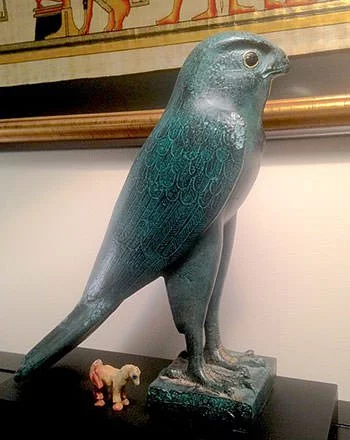
Historians believe that the name Horus is an umbrella term for various falcon deities of ancient Egyptian mythology. One such historian, Jimmy Dunn believes that as “Horus takes so many avian forms, it is impossible to certainly say which form of the deity is his actual form”. Nonetheless, Horus was primarily worshiped as the God of the Sky; and of kingship. Being the god of the sky, Horus was said to contain the sun and the moon. While his right eye was the sun or morning star, representing power and quintessence; his left eye was the moon or evening star, representing healing. Horus was usually depicted as a falcon-headed man wearing the pschent. Pschent is a red and white crown which was used as a symbol of kingship over the entire kingdom of Egypt.
#2 HORUS THE ELDER WAS ONE OF THE FIRST FIVE ORIGINAL GODS
In Egyptian mythology, the name Horus is primarily used for two deities Horus the Elder and Horus the Younger. The latter is the son of Osiris and Isis who plays a prominent role in the Osiris Myth. Horus the Elder, also known as Horus the Great, was one of the oldest deities in Ancient Egypt. He was the son of Geb (earth) and Nut (sky); and the last born of the first five original gods: Osiris, Isis, Set, Nephthys and Horus. While his brother Osiris and his sister Isis were given the responsibility of governing the earth, Horus the Elder was given charge of the sky, specifically the sun.
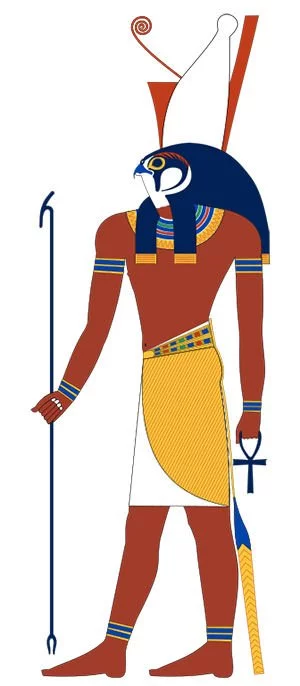
One of the earliest images from Ancient Egypt show Horus as “a falcon in a barque” representing him in the sun barge traveling across the heavens. As time progressed, Horus the Younger started eclipsing the Elder Horus while assuming many of his characteristics. By the Ptolemaic Dynasty (323-30 BCE), the last dynasty of Ancient Egypt, Horus the Younger had completely replaced the Elder Horus.
#3 HORUS THE YOUNGER WAS THE SON OF OSIRIS AND ISIS
The Osiris myth is the most important as well as famous story in ancient Egyptian mythology. According to the myth, Osiris, and his wife, Isis, were the rulers of the world shortly after its creation. Men and women were initially highly uncivilized. However, due to the gifts of Isis and the teachings of Osiris, they were taught the art of agriculture; culture; and a way to live a civilized life. Set, the younger brother of Osiris, became envious of the power Osiris held. He tricked Osiris into laying into a coffin, locked it and threw it into the river Nile.
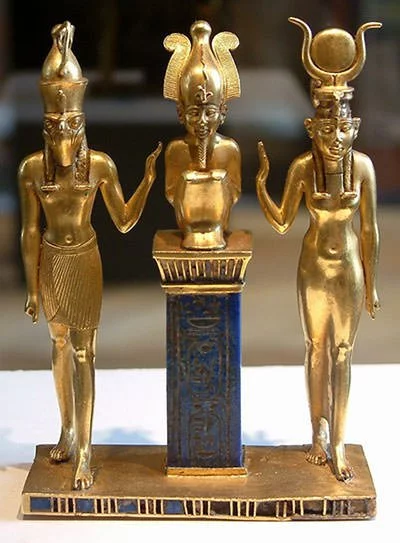
When Isis learned of this, she set out to find the coffin to bring her husband back to life. Set became aware of this plan, cut the body of Osiris and threw the different parts on land and the river Nile. Isis tried to find the parts of Osiris’s body but was unable to find his penis, which had been eaten by a fish. Due to this, even after returning to life, Osiris could not rule the kingdom again. He had to descend to the underworld and thus he became the God of the Underworld. Isis transformed into a falcon, flew around her husband’s body, drew his seed into her body and became pregnant with Horus.
#4 HE FOUGHT WITH HIS UNCLE SET TO WIN THE THRONE OF EGYPT
Isis gave birth to Horus while hiding from Set. She is offered protection from Set by the goddesses Selket and Neith. Horus was thus nurtured and educated by three goddesses. When Horus became an adult and strong enough to take on his uncle Set, he challenged Set for the throne of Egypt. The story about the conflict between Horus and Set has various versions but the most well-known and widely accepted story is mentioned in the manuscript ‘The Contendings of Horus and Set’.

A council of gods was responsible for resolving the conflict between Set and Horus. While most Gods chose Horus as the successor to his father’s throne; Ra, the supreme god, supported Set because he was older and therefore, wiser and more experienced. Due to this, the conflict went on for more than 80 years. The two had to go through a series of battles to prove their competence for the throne. During the battles, both Horus and Set were severely injured. Horus lost his left eye and Set was castrated. Even though all the battles are won by Horus, Ra continues to deny him his rightful position. This leads to Isis tricking Set into condemning himself and Horus ultimately becomes the ruler of Egypt.
#5 EGYPTIAN PHARAOHS HAD A HORUS NAME
Set was associated with violence and chaos in Ancient Egypt. Thus the triumph of Horus in the Osiris Myth leads to restoration of order in Egypt. Pharaoh was the title that was bestowed upon the monarchs of Ancient Egypt. The pharaoh was seen as a manifestation of Horus in life and Osiris in death. New incarnations of Horus were believed to succeed the deceased pharaoh on earth in the form of new pharaohs. One of the major roles of the pharaoh was that of an administrator and due to this they tried to associate themselves with Horus, as he represented order and peace.
Pharaohs had a number of titles and, by the Middle Kingdom (2055 BCE – 1650 BCE), the full royal titulary consisting of five names came into usage. The Horus Name is the oldest form of the pharaoh’s name and the most important. It conveyed that the King was the earthly embodiment of Horus. Moreover, there was also a Golden Horus Name. Its meaning is contested. It probably means that the pharaoh wishes to be Horus for eternity.
#6 THE GREEK GOD HARPOCRATES WAS ADAPTED FROM HORUS
In the early Egyptian Dynasty, the elder Horus was worshiped by the people of Egypt and was considered the most powerful god among all. However, by the time of the Ptolemaic Dynasty, it was the younger Horus who became people’s idol. Statues and figures discovered from that period show Horus as a young child with his finger on his lips. Historians believe that the figure is a representation of Horus while he is silent in fear of his uncle, Set.
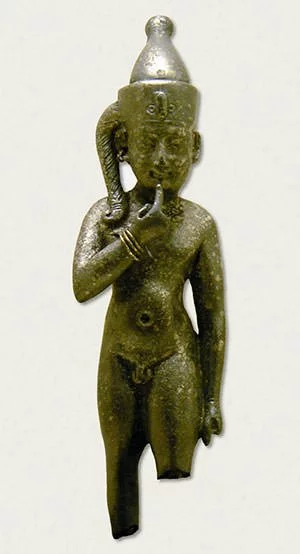
The sufferings and difficulties that Horus faced throughout his childhood became an inspiration for the people of Egypt during the Ptolemaic Dynasty. They believed that the young form of Horus represented the protection offered by God to the human civilization. The Ancient Greeks adopted this form of Horus as their God Harpocrates, which was their god of silence, secrets and confidentiality. In fact, the name Harpocrates is a Hellenization of an Egyptian word which means “Horus the Child”.
#7 THE EYE OF HORUS IS ONE OF THE MOST FAMOUS SYMBOLS OF ANCIENT EGYPT
During the struggle between Set and Horus, Set ripped out the left eye of Horus and tore it into six parts. The lost eye of Horus was magically restored by Thoth, the god of wisdom. The magically restored Eye of Horus, also known as the Wadjet, is one of the best-known symbols of ancient Egypt; and it was believed to provide protection, health, and rejuvenation. Among other things, funerary amulets were often made in the shape of the Eye of Horus as it was believed that it would “protect the pharaoh in the afterlife” by guarding against evil.
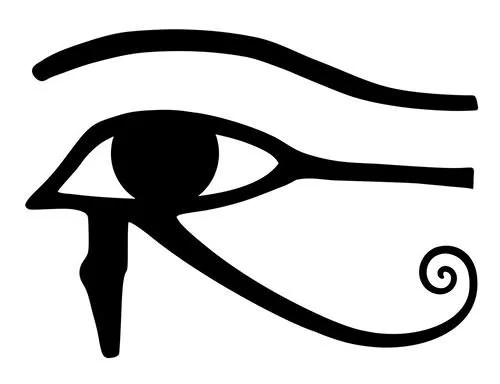
Interestingly, the Eye of Horus was also used by the Egyptians for mathematics. As it was tore by Set into six parts, the Egyptians used the six parts to represent one divided by the first six powers of two. The right side of the eye is 1/2, the pupil 1/4, the eyebrow 1/8, the left side of the eye 1/16, the curved tail 1/32 and the teardrop 1/64. Even today, some people believe that the Eye of Horus possesses magical abilities. Some wear it as jewelry to protect themselves from ill-will while in Mediterranean countries, fishermen paint it on their vessels for protection. Moreover, it is used in occult and considered by some as a satanic symbol.
#8 HIS FOUR SONS ARE CONSIDERED PERSONIFICATIONS OF THE FOUR CANOPIC JARS
Horus has four sons – Duamutef, Hapi, Imsety and Qebehsenuef – each of whom protected one of his vital organs after his death. Through his four Sons, who protected his vital organs, Horus was able to look over the land of the living. The four sons of Horus were depicted on the four canopic jars, which accompanied mummified bodies. They were said to act as guardians of the organs in the jars. The four gods represented the cardinal points of a compass and were in turn protected by four different goddesses.
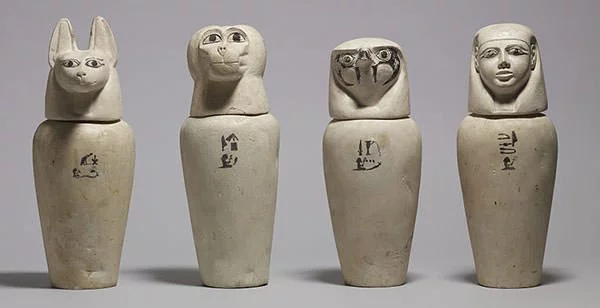
Hapi, who is baboon-headed, protected the lungs of the deceased and was in turn protected by the goddess Nephthys. Imsety, who is human-headed, protected the liver of the deceased and was in turn protected by the goddess Isis. Duamutef, who is jackal-headed, protected the stomach of the deceased and was in turn protected by the goddess Neith. Lastly, Qebehsenuef, who is falcon-headed, protected the intestines of the deceased and was in turn protected by the goddess Serket.
#9 SOME SCHOLARS HAVE RELATED HORUS TO JESUS CHRIST
The controversial topic of the relation between the Cult of Horus, the Cult of Isis and early concepts of Christianity has led to many significant debates about the origin of the religion. In 1877, William R. Cooper, a young lawyer and Egyptologist, published a work titled The Horus Myth In Its Relation To Christianity. In this work, he highlighted many similarities between Horus and Jesus Christ. More recently, author Tom Harpur, in his 2004 book The Pagan Christ: Recovering the Lost Light, claimed that Jesus Christ is just another form of Horus. He argued that themes such as virgin birth, deity father, star in the east, raising of the dead, descent into hell, crucifixion and resurrection were common to both Christ and Horus.

However, experts and scholars of Egyptian Mythology as well as Christianity and Biblical Studies have rejected such claims. According to them, the foundation of Egyptian religious beliefs and Christianity are different because whereas Christianity promotes the concept of resurrection, ancient Egyptian beliefs are focused on the afterlife.
#10 HIS PRIMARY CULT CENTERS WERE KHEM, PE AND BEHDET
Horus was one of the most important deities in Ancient Egypt. Numerous temples were built for him. His statue was placed within the inner sanctum where only the chief priest was allowed to attend him. The sites where Horus was worshiped are too numerous to list. His major cult centers were Khem, where he was hidden as a child; Pe, where he lost his eye in his battle with Set; and Behdet. All these sites were in the Delta region of Egypt.
Horus remains a prominent figure in the pop culture of today and he appears in numerous films, television series and games. Stargate SG-1 is a Canadian-American military science fiction adventure television series which was hugely successful and won numerous awards. Horus appears in Stargate SG-1 as the son of Ra and Hathor. In the 2016 film Gods of Egypt, Horus is a prominent character as the movie follows his battle to reclaim his throne from his uncle Set. Horus is also one of the deities in the video game Smite, in which players choose a deity to take part in team-based combat.

